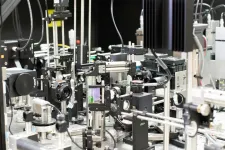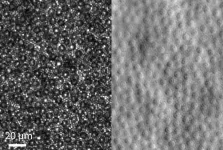ADHD: Aggressive behavior is genetically coded
An international collaboration headed by researchers from iPSYCH has found genetic variants that increase the risk of aggression in children with ADHD
2021-03-11
(Press-News.org) An international collaboration headed by researchers from iPSYCH has found genetic variants that increase the risk of aggression in children with ADHD. In the same study, the researchers also discovered that the genetics which increase aggression in some children with ADHD, are the same genetics that affect aggression in children without a diagnosis.
For the first time, researchers have found positions in the genome that increase the risk of getting ADHD with disruptive behaviour disorders (DBDs). DBDs are child psychiatric disorders characterised by antisocial and aggressive behaviours. The findings have been made by the Danish iPSYCH consortium and the Psychiatric Genomics Consortium.
The results can be used to gain an understanding of the biology that leads to ADHD with DBDs, which 20-30 per cent of children with ADHD have.
The researchers analysed the genome from 3,802 children with ADHD and DBDs and 31,305 without and identified three specific locations in the genome that increase the risk of having ADHD with DBDs. One particular genetic variant located on chromosome 11 increases the risk of seems to specific to the aggressive behaviour.
The new study also show that the aggressive behaviour in children with ADHD and DBDs in part can be explained by genetics.
"We've also compared our results with results from another large genetic study of aggression in children who do not have a child psychiatric disorder. We discovered that the genetics involved in ADHD with DBDs to a great extent is shared with the genetics involved in aggression in the general population," says Ditte Demontis, who is one of the researchers behind the study. She is associate professor at Aarhus University and part of the iPSYCH research project, which is where a major part of the data used in the study comes from.
"In other words the genetics that affect aggression in children with ADHD with DBDs are the same as the genetics that underlie aggression in general. Children with ADHD with behavioural disorders have been unlucky and have received many of the genetic variants that increase the risk of aggressive behaviour," says Ditte Demontis.
The results have been published in the scientific journal Nature Communications.
"The results of our study have revealed a small part of the biological mechanisms in the body involved in ADHD with DBDs," says Ditte Demontis.
ADHD and DBDs are both complex disorders in which both environment and genetics affect the risk.
"The genetic risk is comprised of many genetic variants, each of which increases the risk slightly. This means that the genetic variants we have identified in this study only represents the tip of the iceberg," says Ditte Demontis, and emphasises that this is only the first step on the road towards fully understanding the biological mechanisms underlying ADHD with DBDs.
The research results - more information
The study is a genome-wide association study. That is to say, a study in which genetic variants distributed across the entire genome (more than eight million genetic variants in each person) are analysed in order to identify variants that are over-represented in people with ADHD with DBDs compared with people who do not have the disorders.
INFORMATION:
Partners: The international Psychiatric Genomics Consortium.
Financed by the Lundbeck Foundation.
The scientific article can be read in Nature Communications.
Contact
Associate Professor Ditte Demontis
Aarhus University, Department of Biomedicine
Email: ditte@biomed.au.dk
Mobile: (+45) 2853 9746
ELSE PRESS RELEASES FROM THIS DATE:
2021-03-11
Most new achievements in artificial intelligence (AI) require very large neural networks. They consist of hundreds of millions of neurons arranged in several hundred layers, i.e. they have very "deep" network structures. These large, deep neural networks consume a lot of energy in the computer. Those neural networks that are used in image classification (e.g. face and object recognition) are particularly energy-intensive, since they have to send very many numerical values from one neuron layer to the next with great accuracy in each time cycle.
Computer scientist Wolfgang Maass, together with his PhD student Christoph Stöckl, has ...
2021-03-11
The genetics of human eye colour is much more complex than previously thought, according to a new study published today.
An international team of researchers led by King's College London and Erasmus University Medical Center Rotterdam have identified 50 new genes for eye colour in the largest genetic study of its kind to date. The study, published today in Science Advances, involved the genetic analysis of almost 195,000 people across Europe and Asia.
These findings will help to improve the understanding of eye diseases such as pigmentary glaucoma and ocular albinism, where eye pigment levels play a role.
In addition, the team found ...
2021-03-11
Extremely preterm infants can suffer from a life-threatening inflammation of the gut. A new clinical study has shown that supplements of a lactic acid bacterium may have positive effects by increasing the diversity of intestinal bacteria in these infants. The study has been led by researchers at Linköping University, Sweden, and published in the scientific journal Cell Reports Medicine.
A litre of milk weighs a kilogram. Most infants who are born extremely prematurely weigh less than that. An infant who should have developed and grown for three more months in the protective environment of the mother's womb is, of course, extremely vulnerable. As a consequence of advances in neonatal care, many premature infants survive, although one out of four of the extremely ...
2021-03-11
Robots solving computer games, recognizing human voices, or helping in finding optimal medical treatments: those are only a few astonishing examples of what the field of artificial intelligence has produced in the past years. The ongoing race for better machines has led to the question of how and with what means improvements can be achieved. In parallel, huge recent progress in quantum technologies have confirmed the power of quantum physics, not only for its often peculiar and puzzling theories, but also for real-life applications. Hence, the idea of merging the two fields: on one hand, artificial intelligence ...
2021-03-11
Scientists have discovered a route of introduction for High Pathogenicity Avian Influenza Virus (HPAIV) H5N8 into Japan and, in parallel, have investigated the potential of two human anti-influenza drugs for the control of HPAI in birds.
Since October 30, 2020, there have been over 30 recorded outbreaks of High Pathogenicity Avian Influenza (HPAI) in domestic poultry and wild fowl in Japan. This outbreak was caused by the influenza A virus H5N8, a known High Pathogenicity Avian Influenza Virus (HPAIV). In such a scenario, identification of the source of the virus and its transmission route is important to control its spread.
A team of scientists led by Professor Yoshihiro Sakoda of Hokkaido University have recently found the probable route of introduction of ...
2021-03-11
WASHINGTON -- Researchers have developed a noninvasive technique that can capture images of rod and cone photoreceptors with unprecedented detail. The advance could lead to new treatments and earlier detection for retinal diseases such as macular degeneration, a leading cause of vision loss.
"We are hopeful that this technique will better reveal subtle changes in the size, shape and distribution of rod and cone photoreceptors in diseases that affect the retina," said research team leader Johnny Tam from the National Eye Institute. "Figuring out what happens to these cells before they are lost is an important step toward developing earlier interventions to treat and prevent blindness."
In Optica, The Optical Society's (OSA) journal for high impact research, the researchers show that ...
2021-03-11
A team led by scientists at the National Eye Institute (NEI) has noninvasively visualized the light-sensing cells in the back of the eye, known as photoreceptors, in greater detail than ever before. Published in Optica, the researchers report how they improved imaging resolution by a third by selectively blocking the light used to image the eye. NEI is part of the National Institutes of Health.
The achievement is the latest in an evolving strategy to monitor cell changes in retinal tissue that, in turn, will help identify new ways to treat and prevent vision loss from diseases such as age-related macular degeneration, a leading cause of blindness in people age ...
2021-03-11
DALLAS, March 11, 2021 -- Non-O blood type may increase the risk of stroke among women who smoke and take oral contraceptives, according to preliminary research to be presented at the American Stroke Association's International Stroke Conference 2021. The virtual meeting is March 17-19, 2021 and is a world premier meeting for researchers and clinicians dedicated to the science of stroke and brain health.
According to the most recent comprehensive data (January 2020) from the Centers for Disease Control and Prevention (CDC), stroke is the fifth leading cause of death in the United States and a major contributor to long-term disability. Some risk factors ...
2021-03-11
Rainbows are some of the most spectacular optical phenomena in the natural world and Hawai'i has an amazing abundance of them. In a new publication, an atmospheric scientist at the University of Hawai'i at Mānoa makes an impassioned case for Hawaii being the best place on Earth to experience the wonder of rainbows. He begins by highlighting the Hawaiian cultural significance of rainbows, he reviews the science of rainbows and the special combination of circumstances that makes Hawai'i a haven for rainbows.
"The cultural importance of rainbows is reflected in the Hawaiian language, which has many words and phrases to describe the variety of manifestations in Hawai'i," said author Steven Businger, professor in the UH ...
2021-03-11
DALLAS, March 11, 2021 -- Stroke patients were nearly 50% more likely than heart attack patients to develop depression, and female stroke patients had a higher risk of depression than their male counterparts, according to two preliminary studies by the same research group to be presented at the American Stroke Association's International Stroke Conference 2021. The virtual meeting is March 17-19, 2021 and is a world premier meeting for researchers and clinicians dedicated to the science of stroke and brain health.
In what researchers described as one of the largest ...
LAST 30 PRESS RELEASES:
[Press-News.org] ADHD: Aggressive behavior is genetically coded
An international collaboration headed by researchers from iPSYCH has found genetic variants that increase the risk of aggression in children with ADHD




